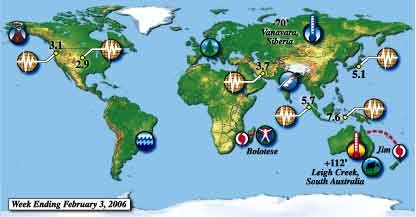Vulture Extinction
Conservation groups in India met with government officials to
convince them to ban a common cattle medication that threatens to
bring the country’s vultures to extinction within a few years. The
government promised last March to phase out veterinary use of the
drug diclofenac, but the move has faced opposition from the
pharmaceutical companies that produce it.
By Steve Newman
Vulture Extinction
Conservation groups in India met with government officials to convince them to ban a common cattle medication that threatens to bring the country’s vultures to extinction within a few years. The government promised last March to phase out veterinary use of the drug diclofenac, but the move has faced opposition from the pharmaceutical companies that produce it. Scientists say a switch to the use of meloxicam, which does not harm the birds, could resolve the crisis. They also note that populations of the three threatened vultures have plummeted in South Asia by more than 97 percent over the past 15 years due to the widespread use of diclofenac to treat sick cattle. With the disappearance of the scavenger birds, feral dogs now flourish on dead animals, and there are fears that both the dogs and the rotting carcasses that litter the countryside will spread disease to humans.
German Oak Peril
Climate change is ravaging Germany’s once magnificent forests, with researchers announcing that one in every two oak trees is officially sick. The country’s agriculture ministry says that the phenomenon of Waldsterben, or forest death, reversed slightly last year but pollution and global warming are still taking a heavy toll. Germany’s Friends of the Earth environmental group blame carbon dioxide emissions for creating global warming heat waves during 2002 and 2003, which joined with other air pollution to damage the trees’ health. Group spokesman Rüdiger Rosenthal said that while pine trees appear to be unaffected, the oaks, which can live up to 1,000 years, could die out completely within the next two decades.
Crippling Epidemic
An outbreak of a crippling and incurable mosquito-borne disease has spread to more than 50,000 people on the Indian Ocean island of Reunion. Within the past week, health officials reported more than 5,600 new cases of people infected with “chikungunya,” a Swahili word for “that which bends up.” The term refers to the stooped posture of those afflicted by the non-fatal disease for which there is no known vaccine or cure. Schools have been closed, and the health ministry has called for actions to be taken to eradicate mosquitoes across the popular tourist resort island.
Rio Cloudburst
The heaviest rainstorm to strike the Brazilian city of Rio de Janeiro in nearly a decade killed more than 12 people and brought the city to a near standstill. Six of the victims died after becoming trapped by rising waters in the lowest level of a shopping mall garage. Another died under the rubble of a house that collapsed. Flash flooding from the downpours forced Rio’s two airports and two largest hospitals to shut down.
Earthquakes
A magnitude 7.6 temblor rocked a wide area of Indonesia and was felt as far away as Darwin, Australia. Two people were trampled to death when the shaking beneath the Banda Sea caused panicked residents of Ceram to rush to higher ground in fear of a tsunami. Cracks appeared in buildings there and in East Timor.
Earth movements were also felt in northwest Sumatra, southern Iran, metropolitan Tokyo, northern Nebraska and around Portland, Ore.
Tropical Cyclones
Cyclone Jim skirted the French South Pacific territory of New Caledonia. Remants of the storm were predicted to move over northern New Zealand.
Minimal Cyclone Bolotese weakened to tropical depression strength before it passed over Madagascar. The storm then regenerated and reached category 1 strength over the Mozambique Channel.
Alaskan Eruption
Alaska’s Augustine Volcano roared back to life following 10 days of relative calm, spewing a cloud of ash that soared 40,000 feet into the sky southwest of Anchorage. It was the 10th explosion since Jan. 11, when the 4,134-foot Cook Inlet volcano ended 30 years of dormancy.
Devil Cancer Spreads
A cancer that has been killing Tasmanian devils was discovered near a “disease free” national park on the Australian island state from which the animal got its name. The Devil Disease Project confirmed that a dead devil found within 6 miles of the Narawntapu National Park was infected with the deadly facial tumor disease. The tumors can become so large that they force the teeth from a devil’s mouth, leaving it to die of starvation. “We’ll be looking at some disease suppression activities, including the trapping and removal of diseased devils, if the disease is found within the park,” said project leader Alistair Scott. The foul-tempered creatures are about the size of a small dog, with sharp teeth, powerful jaws and a screech that earned them the name.














